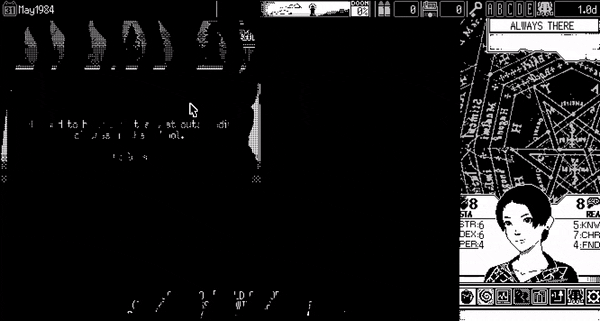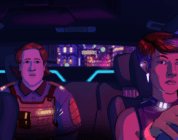How can a horror game with a graphical look pulled straight from a black-and-white 1980s Apple IIe manage to instill fear and dread? In a world of high-fidelity jump scares and graphic violence that would make ‘80s slasher movie makers say “That might be a little over the top”, can a tiny indie horror game blending Lovecraftian and Japanese horror elements bring something new to this blood-saturated genre?
We got our very first look at World of Horror almost five years ago when it debuted at PAX South 2019. (You can go back and re-read our first impressions here.) From that small vertical slice, the game evolved into a substantial horror rogue-like, with substantial replayability and deep roots in two different mythologies. As a bonus, the original vertical slice demo level is still playable and serves as a tutorial introduction to the game.
World of Horror puts the player in the shoes of an investigator returning to his or her (depending on the playthrough) hometown, and discovering that some things have begun to go horribly wrong in oddly twisted ways. The backdrop is a mixture of Lovecraftian Old Ones slowly emerging into this universe, but many of the more immediate threats draw from Japanese mythology. All sorts of Yokai monsters from folklore show up to potentially cause the player’s character severe harm.
For each playthrough, the player must solve five randomly selected mysteries before proceeding to a final mystery and battle to stop an Old One from breaking through the barrier between worlds. Players have the option of running a quick start game where everything is randomly selected or take control of their own destiny by choosing their character, background, and Old One. All of these choices affect the game with various bonuses and debuff modifiers.
Each mystery also features multiple possible endings. Unlocking different endings is the key to opening up additional playthrough options (as is common in most rogue-likes). It is possible to reroll the mystery list if a player is gunning for completion territory and trying to get every ending for every mystery.
Control is nearly all mouse-based. Combat and world choices are turn-based, allowing for decisions to be made as quickly as your creeping dread will allow. In some ways, more resource management sim than anything else. Every encounter, every choice, comes with a cost. Stamina, or Reason? Lose all your character’s Stamina and the game is over. You’re dead. Lose all your Reason, and the game is also over. You’re insane. Take some time to replenish either one of those character aspects and the Doom clock ticks a few steps closer to the end of the world. What to do? What to decide?

All paths eventually lead to the lighthouse. Each solved case gives a key to unlock part of the door.
The UI generally provides all the information a player needs, however, some things, such as money, aren’t called out well. One surprising omission is the lack of cloud saves. Not a dealbreaker by any means, but for a game with low system requirements, the ability to port progress across multiple devices would have been a nice addition.
Arguably the thing that really sets World of Horror apart from most other modern horror games, however, it its commitment to a retro look. Simply put, the game looks the way we remember early PC games as looking. Granted, the actual fidelity of ‘80s games was far worse than this, but in our memories, this is how those classic adventure games appeared. In this aspect, the game does a great job. Players can slightly swap the color palettes (with the 2-bit mode supporting four colors). Coupled with the haunting chiptunes soundtrack, the game does a great job of pulling the player in and letting the imagination fill in the gaps around the black-and-white pictures on the screen.
Not to mention, many of the cases are sufficiently well crafted, with such disturbing subject matter, that the lack of modern graphics is still more than enough. One case in particular, involving tiny eels infesting the eye of the player character’s friend, had this reviewer squirming in his chair while making a mystery-defining decision. Because of World of Horror’s roguelike sensibilities, players can whip through a single playthrough in less than an hour, but mastering all of the game’s mysteries and unlocking the variety of hidden features, optional endings, and achievements will take much, much longer.
The game does an excellent job of mixing its retro graphics and strong story elements into an appealing, psychologically traumatizing, package. Much like a classic Hitchcock film, or one of the really good episodes of The Twilight Zone, World of Horror isn’t disturbing so much from what it shows, but from what it doesn’t show that is left to the player’s imagination.








